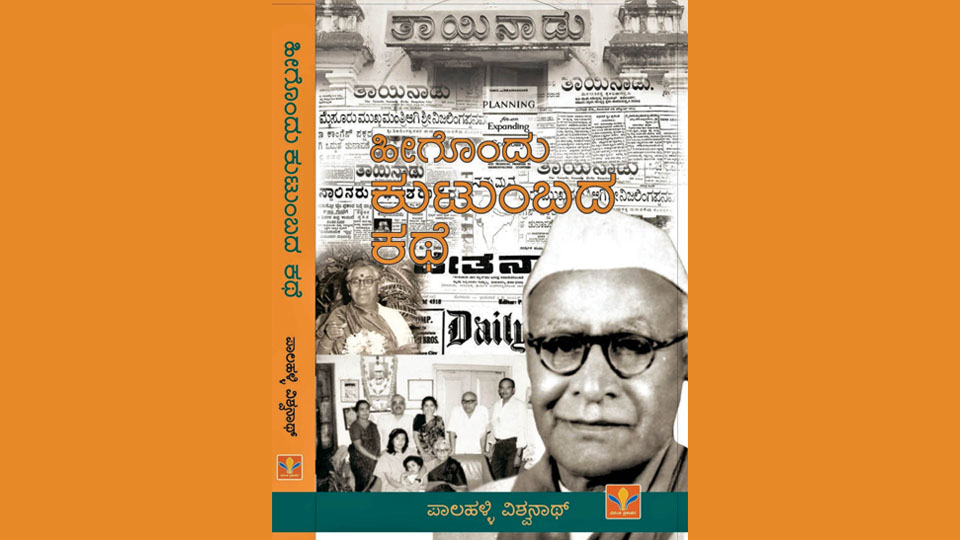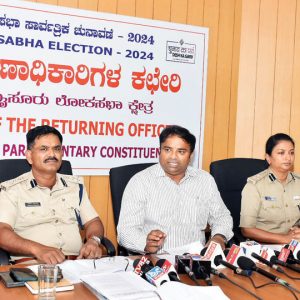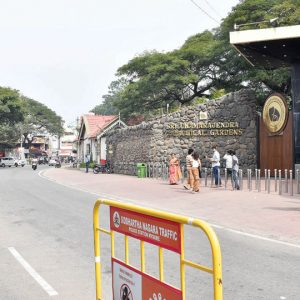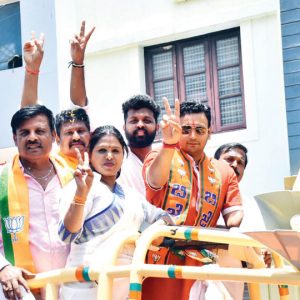By Gouri Satya, Sr. Journalist
- Title : Heegondu Kutumbada Kathe
- Author: Palahalli Vishwanath
- Year: 2021
- Pages: 343
- Price: Rs.280
- Publisher: Vasantha Prakashana, Jayanagar, Bengaluru
As one enters the Lansdowne Building Road from the Jaganmohan Palace Road in Mysuru, one sees a prominent signboard on the first floor of the now neglected heritage building. It reads “Tai Nadu” in Kannada. Though Tai Nadu, a popular Kannada daily, ceased publication long back, the signboard stands prominently drawing the attention of the passers-by on this neglected road.
Tai Nadu took its birth in 1927 in Mysuru as a weekly and ten years later moved to Bangalore and became a very popular Kannada daily. Its founder was P.R. Ramaiah, a veteran journalist and Gandhian, born in Palahalli, near Mysuru. The other main competitor for his morning daily was ‘Vishwa Karnataka’ of Ti. Ta. Sharma or Thirumale Tatacharya Sharma, a well-known writer also, who was another strong critic of the Government. Both were distinguished personalities in journalism and in social life as well. Both were influenced by Gandhiji and his associates of the freedom movement.
P.R. Ramaiah’s wife, P.R. Jayalakshamma, was not lagging behind in popularity. She was a well-known social worker and her popularity had brought her the Deputy Mayor post of the Bangalore City Corporation.
It is interesting to note the object with which Ramaiah launched Tai Nadu — “The Dewan is behaving like a dictator. The objective of this paper is to end his dictatorship.” It was a challenging task in those days to oppose or criticise the policies of the Government when the Dewan and the Maharaja owed loyalty to the British authorities and the British Government was directly or through the Maharaja’s Government taking stern steps against any voice raised in favour of freedom. Consequently, Ramaiah had to face many hurdles, stop his publication on the orders of the Maharaja’s Government. But he did not surrender his pen. He continued to criticise the Government without apprehension or reservation whenever he felt it went against the rights of the people.
The situation in the British-controlled Mysore was such that the Maharaja had to bear in mind that the sword of Damocles remained suspended on his head. He had to make sure that no criticism or agitation rose up against the British authority. The British Resident was there in Mysore ensuring that this was followed strictly, if not directly by himself at least through the Maharaja. The newspapers at that time had to balance their writings in such a way that they would not hurt the Maharaja but oppose the British authority executed through the Maharaja.
The Dewan, Sir Mirza Ismail, was Ramaiah’s friend. But, Ramaiah was his strong critic. He did not hesitate to write sharply any stand of the Dewan against democratic principles. After all, Ramaiah had begun his career in journalism under the ‘Grand-old man of Mysore’ M. Venkatakrishnayya, who was publishing Sampadabhyudaya weekly in Mysore. Ramaiah’s initial career and the influence cast by Venkatakrishnayya, who can be hailed as the Father of Journalism in Mysore, shaped Ramaiah’s future and the bold stand of his daily. Thatayya, as Venkatakrishnayya was known popularly, was himself a sharp critic of the Government and had faced warnings and threats from the Government but carried on his writings without flinching from his stand or conviction.
Ramaiah had to face many challenges for his bold writings in Tai Nadu. The then Mysore Municipal Commissioner had given direction to his office not to subscribe for it. Sometime later, Dewan Mirza had sent words to Ramaiah not to send his paper to him. The Government had issued an order directing him to cease publication for 14 days for his report on the disturbances in Bangalore in 1928. Immediately, he started a new publication, New Life and condemned the Magistrate’s order. This was not the only occasion, but on many others too he was forced to stop publication during the freedom struggle.
Ramaiah was put in jail when the Simon Commission visited Bangalore to discuss drawing up a Constitution. But facing all these hardships in addition to financial and other problems related to a printing press, Ramaiah carried on Tai Nadu publication until 1957 when he sold it because of financial hardship.
Ramaiah was also strict with his employees on matters related to norms of journalism. He wanted them to maintain certain standards. For new-comers to the editorial section, he would instruct not to go to any office seeking favours with requests and appeals mentioning the name of Tai Nadu, not to attend any function or programme for reporting unless assigned by the editor, not to seek a pass or a free ticket for any sport or entertainment programme for the sake of reporting.
He had instructed the sub-editors not to have a by-line taking credit for their reports but to remain anonymous, ensure the reports were written in simple language that a reader can understand, to make sure to understand a subject before writing, and to take utmost care while reporting on deaths, legal matters and murders.
He had cultivated these ideals in journalism right from the early days of his career. When he was the sub-editor of Venkatakrishnayya’s Sadhvi, Ramaiah went to cover the Dewan’s tour in Chitradurga district in 1926-27 along with a few colleagues. Complimenting for their reports on his tour, Sir Mirza Ismail sent Rs. 100 in an envelope to each journalist including Ramaiah. With the envelope in his hand Ramaiah went to his Guru and sought his advice.
Venkatakrishnayya in turn asked Ramaiah what he would do with the Dewan’s ‘compliments.’ Without hesitation, he replied, “I went for the sake of my paper and I will get paid for it from you. This gift by the Dewan is therefore unnecessary. If you permit me, I will return it.” This he said despite his financial position. That was the moral conviction of the then journalists, a mirror for the present scenario in the profession.
Palahalli Vishwanath, the younger son of Ramaiah and former Professor at Tata Institute of Fundamental Research, Mumbai, has brought out these interesting details while recording the journey of his father, his family and Tai Nadu in his recent publication, Heegondu Kutumbada Kathe. “This bio book is not just about people but also places and events of those times,” he says.
While weaving the family story in his own style, Vishwanath, brother of renowned economist P.R. Brahmananda and veteran stage artiste Rameshwari Verma, whose uncle late R.S. Narayan secured a Ph.D for his thesis on Gandhiji from the Mysore University, almost at the end of his career as the Correspondent of The Hindu in Mysuru, and a senior colleague to me, unveils the thin screen in history on how the British were not alone responsible to suppress the freedom movement. This is significantly an important point and we find many such lopsided interpretations in the history of Mysore of the British period which calls for a re-look.
This is a must-book for scribes and students of journalism, to realise the ethics of the profession which we see has gone downhill, and how veteran journalists like P.R. Ramaiah struggled to shape it.








Recent Comments